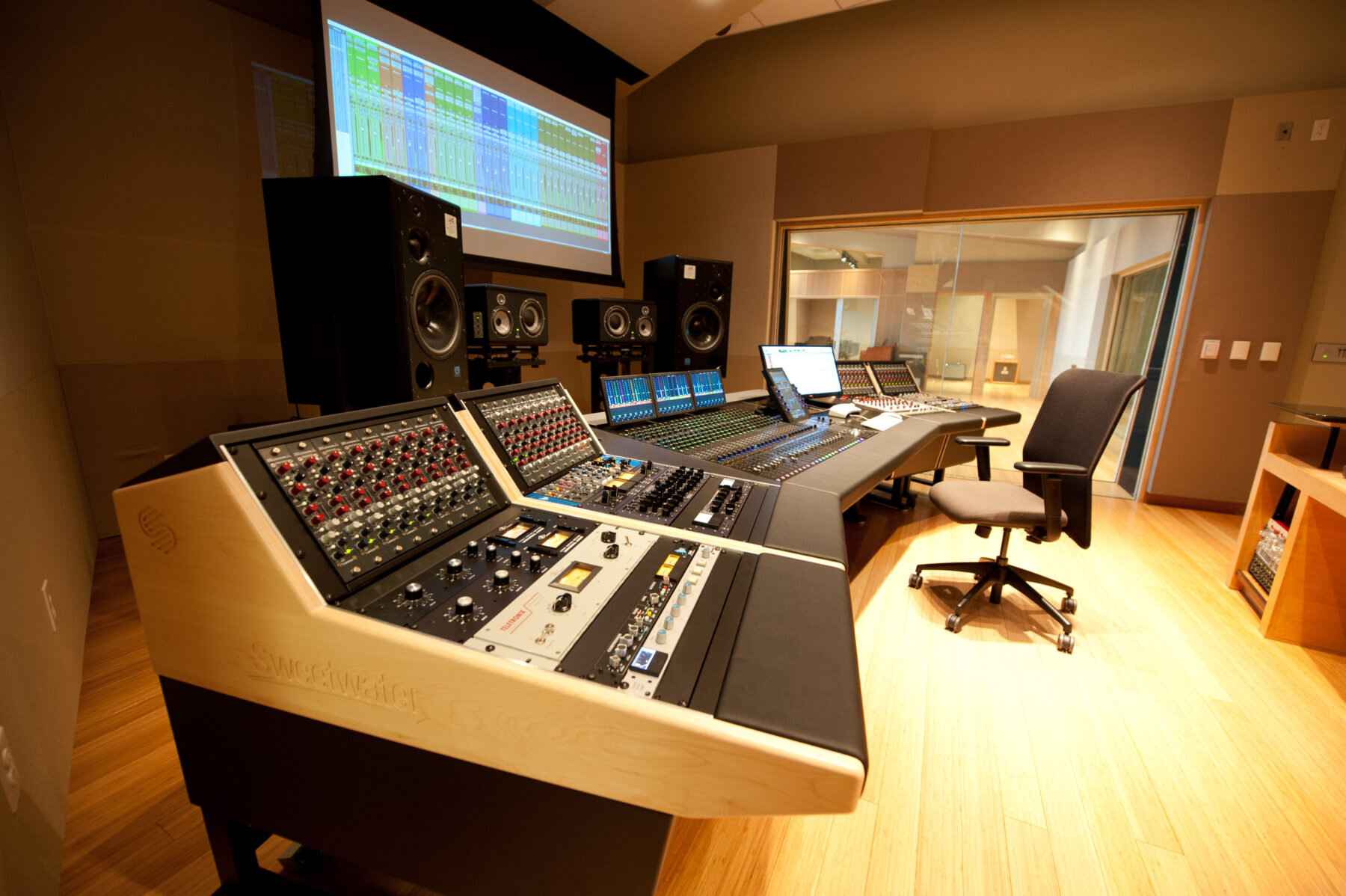A Hybrid Workflow at Sweetwater Studios
Before growing into one of the world’s largest and most successful music retailers, Sweetwater Sound began in 1979 as a recording studio.
It therefore comes as no surprise that Sweetwater also has their own recording studios on premises, which are chock full of some of the most amazing gear on the planet. Here’s how they describe their studios:
“Each of our three studios are world-class acoustic spaces built to accommodate a wide variety of recording projects; designed by the world-renowned Russ Berger Design Group, our studios are versatile enough for anything from singer/songwriters to 10 piece groups – and when you add in our 250 seat Performance Theatre (which is connected to Studio A via audio tie lines and high definition video), we can even handle choirs, orchestral groups, big bands, and other large ensembles. Whatever your needs, we have the right space for you.”
Mark Hornsby, Sweetwater Studios’ Vice President of Operations, was kind enough to do an interview with us about Studio A’s control room, and how Rupert Neve Designs became a part of it. Read on to learn more.
Thanks so much for taking the time to speak with us, Mark. So – as a studio with essentially infinite choices in gear to make, can you tell us a bit about how you landed on this custom desk?
We serve clients all over the world. Being a destination facility, we wanted to provide a system that would suit the needs of anyone, whether it’s artists or other producers and engineers; whether they’re a console-minded person, or prefer a bunch of different outboard gear, or anything in-between. The design of the desk represents that.
I come from Nashville where one the old sayings is ‘Track it on a Neve and mix it on an SSL’. As I got older, I went to tracking AND mixing on Neves. On the front end, the Shelford modules’ preamp sounds killer. With the integration of the Shelfords, in particular the EQ midband, it’s the best of both worlds. To have what sounds like – the 1073 with a little more top end – is great. We have 27 of those [5052] modules, plus nine [5051] EQ/compressors. We get the cohesion of cutting on a Neve console. With a full rhythm section, having everybody going through the same type of preamp – with the same slew rate and all that -and when I use these modules, I think, ‘That’s what it sounds like cutting on a real board.’
The Silk feature takes it one step further. I can leave it out and it sounds like the Neve flavor, but a bit more modern. If I put the blue Silk in, it sounds more familiar to an 80-series Neve. The red Silk is a brighter, more aggressive sound. What I end up doing is a combination of both. Tracking drums – red Silk on kick drum beater mic. Ribbon out in front with blue Silk. I mix and match, especially when stacking guitar tracks. Just the subtle harmonic changes provides a lot of sonic flexibility, but still maintains that ‘console cohesion’. You might say, ‘Man, it just needs a little more top end’…instead of reaching for the EQ, just add a little red Silk.
So you commit with the Silk on the front end?
Absolutely. Forget the “Fix it in the mix” mentality. We get the sound we want and record it that way. If I crank up the red Silk, it’s brighter and more pointed in the midrange. Instead of always swapping the mic, or reaching for the EQ, just using different levels of harmonic distortion is a quick and easy way to craft the sound. We love our 2” tape machine, but the effect of tape is a similar quest. ‘Warmth.’ It’s pleasing to our ears and it’s all about tone. The Silk feature is a very proactive thing that Rupert Neve Designs has done to give engineers-and home studios a like- a lot more tonal flexibility at their fingertips.
Why the Shelford modules, as opposed to actual vintage units – or recreations?
Well, we certainly wanted that sound. For tracking, we wanted the Neve character, but we also didn’t want to be limited given our diverse customer base. If you buy a vintage console, there’s your sound and you’re done. With these modules, we’ve got multiple variations on top of that and therefore have more options to provide our customers.
I don’t know of another mic pre that combines a familiar vintage vibe, tone and sound with modern-day flexibility, in quite the same way. Any engineer that comes in here…I show them what the modules do, and they ‘get it’.
How do the modules fit in with the rest of the studio?
We have an [Avid] S6 driving ProTools, with this great front end sound from the Shelfords. We’ve got ATC 150’s and a sub for mains, and because of their phenomenal midrange, it really gives us an opportunity to hear what Rupert Neve [Designs] has done with these circuits. It suits anybody’s needs. What do you want to do? I mean, the flexibility – tracking, mixing, analog, digital – I’ve seen a lot of people succeed in their home studios, but I haven’t seen a lot of commercial studios do it successfully. We feel we’ve achieved this flexibility.
You’ve got two 5059 Satellites in the rack as well; how often do you find yourself using them?
On the back end, the Satellite mixers sound killer. For rhythm section, heavy stuff, I use them quite a bit. For more ethereal, FX-driven stuff, I don’t lean on the Satellites so much. I always A/B stuff to see what sounds better, but I always start with them. Sometimes they’re just on the drums, sometimes they’re on the whole mix.
Any other Rupert Neve gear in there?
The MBP [Master Buss Processor] – sounds killer, even when you don’t use the compressor section. Just a little of the SFE circuit and limiter on final stage is killer. It’s so subtle…when you’re tracking, you can turn the Shelford’s Silk up 25-40%, and how much you hear can vary. With the MBP, one click of [Silk] red or blue on the two-mix gives you a ton of color.
And the new RNDI is phenomenal. I play bass, and obviously record a lot of bass tracks – since I plugged it in, I don’t think I’ve plugged in another DI since. Granted, I still cut with an amp when it makes sense, but the sound it gave me right off the bat was very focused…it’s a little unusual where I can find a DI for both active and passive basses and smile at both of ‘em. On bass, the RNDI whatever you plug in, it’s that sound.
Any final takeaway for our readers?
Rupert Neve Designs is making killer modules that blow us away, and that’s why it’s the front end of this room. We have other favorites as well, but when you’re a commercial studio, people still look for Neve, SSL, and API name. The new Rupert Neve Designs gear serves that need and sounds phenomenal. Musical, very reminiscent of the vintage stuff – one step better in my opinion. Certainly less noise. And the Silk is just icing on the cake – I can shape tones all day long.





